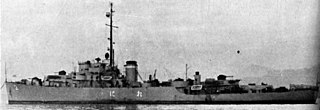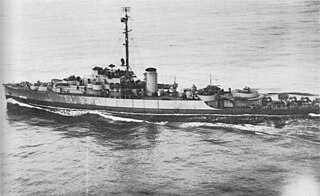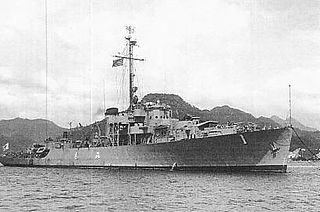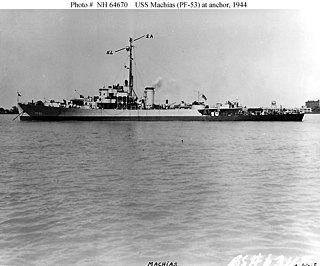
USS Coronado (PG-146/PF-38), a Tacoma-class frigate, was the first ship of the United States Navy named for Coronado, California, a city adjacent to Naval Air Station North Island in San Diego. After World War II service in the U.S. Navy, she served in the Soviet Navy as EK-8 and later in the Japan Maritime Self-Defense Force as Sugi (PF-5) and Sugi (PF-285).

USS Gloucester (PF-22), a Tacoma-class frigate in commission from 1943 to 1945, was the second ship of the United States Navy to be named for Gloucester, Massachusetts. She later served in the Soviet Navy as EK-26 and in the Japan Maritime Self-Defense Force as JDS Tsuge (PF-12) and JDS Tsuge (PF-292).

USS Sandusky (PF-54), a Tacoma-class frigate in commission from 1944 to 1945, was the second United States Navy ship of the name and the first to be named for Sandusky, Ohio. She later served in the Soviet Navy as EK-7 and in the Japan Maritime Self-Defense Force as JDS Nire (PF-7), Nire (PF-287) and as YAC-19.

USS San Pedro (PF-37), a Tacoma-class frigate in commission from 1943 to 1945, thus far has been the only ship of the United States Navy to be named for San Pedro, California. She later served in the Soviet Navy as EK-5 and in the Japan Maritime Self-Defense Force as Kaya (PF-8), Kaya (PF-288) and as YAC-23.
The first USS Ogden (PF-39) was a Tacoma-class frigate in commission from 1943 to 1945. Originally classified as PG-137, she was the first ship of the United States Navy to be named for Ogden, Utah. She later served in the Soviet Navy as EK-10 and in the Japan Maritime Self-Defense Force as Kusu (PF-1), Kusu (PF-281), YAS-50 and YAC-22.

USS Poughkeepsie (PF-26), a Tacoma-class frigate in commission from 1944 to 1945, was the first ship of the United States Navy to be named for Poughkeepsie, New York. She later served in the Soviet Navy as EK-27 and in the Japan Maritime Self-Defense Force as JDS Momi (PF-4), JDS Momi (PF-284), and as YAC-13.

USS Allentown (PF-52), a United States Navy Tacoma-class frigate in commission from 1944 to 1945, has thus far been the only U.S. Navy ship to be named for Allentown, Pennsylvania. She later served in the Soviet Navy as EK-9 and in the Japan Maritime Self-Defense Force as JDS Ume (PF-9), JDS Ume (PF-289) and as YAC-14.

USS Albuquerque (PG-115/PF-7), a Tacoma-class patrol frigate in commission from 1943 to 1945 and from 1950 to 1953, was the first ship of the United States Navy to be named for Albuquerque, New Mexico. She also served in the Soviet Navy as EK-14 and in the Japan Maritime Self-Defense Force as JDS Tochi (PF-16/PF-296) and as YAC-15.
USS Evansville (PF-70), a Tacoma-class frigate in commission from 1944 to 1945 and from 1950 to 1953, was the second ship of the United States Navy to be named for Evansville, Indiana. She also served in the Soviet Navy as EK-30 and in the Japan Maritime Self-Defense Force as JDS Keyaki (PF-15), JDS Keyaki (PF-295) and YAC-21.

USS Pasco (PG-114/PF-6), a Tacoma-class patrol frigate in commission from 1944 to 1945, has thus far been the only ship of the United States Navy to be named for Pasco, Washington. She later served in the Soviet Navy as EK-12 and in the Japan Maritime Self-Defense Force as JDS Kashi (PF-3/PF-283) and as YAC-12.

USS Everett (PG-116/PF-8), a Tacoma-class patrol frigate in commission from 1944 to 1945 and from 1950 to 1953, thus far has been the only ship of the United States Navy to be named for Everett, Washington. She also served in the Soviet Navy as EK-15 and in the Japan Maritime Self-Defense Force as JDS Kiri (PF-11/PF-291/YAC-20).
USS Newport (PF-27), a Tacoma-class frigate in commission from 1944 to 1945, and from 1950 to 1952, was the second ship of the United States Navy to be named for the city of Newport, Rhode Island. She later served in the Soviet Navy as EK-28 and in the Japan Maritime Self-Defense Force as JDS Kaede (PF-13), JDS Kaede (PF-293) and as YAC-17.

The second USS Long Beach (PF-34) was a Tacoma-class frigate in commission from 1943 to 1945. She later served in the Soviet Navy as EK-2 and then in the Japan Maritime Self-Defense Force as Shii (PF-17) and Shii (PF-297) and YAS-44.

USS Glendale (PF-36), a Tacoma-class patrol frigate, was the only ship of the United States Navy to be named for Glendale, California. In commission in the US Navy from 1943 to 1945, and from 1950 to 1951, she also served in the Soviet Navy as EK-6 from 1945 to 1949 and in the Royal Thai Navy as Tachin (PF-1) from 1951 to 2000.

USS Bayonne (PF-21), a Tacoma-class frigate in commission in 1945 and from 1950 to 1953, thus far has been the only ship of the United States Navy to be named for Bayonne, New Jersey. She later served in the Soviet Navy as EK-25 and in the Japan Maritime Self-Defense Force as JDS Buna (PF-14), JDS Buna (PF-294) and as YAC-11.
USS Belfast (PF-35), the only ship of the name, was a United States Navy Tacoma-class frigate in commission from 1943 to 1945. She then served in the Soviet Navy as EK-3.

USS Rockford (PF-48), a Tacoma-class frigate in commission from 1944 to 1945, thus far has been the only ship of the United States Navy to be named for Rockford, Illinois. She later served in the Soviet Navy as EK-18 and in the Republic of Korea Navy as ROKS Apnokkang (62).

USS Carson City (PF-50), a Tacoma-class frigate in commission from 1944 to 1945, thus far has been the only ship of the United States Navy to be named for Carson City, Nevada. She later served in the Soviet Navy as EK-20 and in the Japan Maritime Self-Defense Force as JDS Sakura (PF-10), JDS Sakura (PF-290) and as YAC-16.

The second USS Machias (PF-53) was a United States Navy Tacoma-class frigate in commission from 1944 to 1945 which later served in the Soviet Navy as EK-4 and the Japan Maritime Self-Defense Force as JDS Nara (PF-2), JDS Nara (PF-282) and YTE-8.
The second USS Bath (PF-55) was a United States Navy Tacoma-class frigate in commission from 1944 to 1945 which later served in the Soviet Navy as EK-29 and the Japanese Maritime Self-Defense Force, with her Japanese name reported by various sources as JDS Maki (PF-18) and JDS Maki (PF-298), and later as YTE-9.














